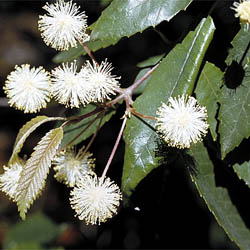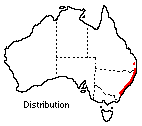Callicoma serratifolia
 |
Black Wattle, Butterwood
Callicoma serratifolia Andrews
Callicoma serratifolia is a plant of historic interest as the first timbers used for the wattle and daub huts of the early settlers were cut from these trees. This plant was common at that time around Sydney Cove. Because of the close resemblance of its flowers to those of Acacia it was then known as black wattle, a name which is now applied more appropriately to some true Acacia species.
 This
genus is in the small family Cunoniaceae and contains only one species which
is confined to Australia. It grows naturally as a bushy shrub or small tree
to 12 m high in protected moist gullies usually in close proximity to creeks.
It occurs along the coastal areas of New South Wales from the Braidwood district
to south-east Queensland. In cultivation it is an attractive ornamental small
tree reaching a height of 6-10 m with a diameter of 3 m.
This
genus is in the small family Cunoniaceae and contains only one species which
is confined to Australia. It grows naturally as a bushy shrub or small tree
to 12 m high in protected moist gullies usually in close proximity to creeks.
It occurs along the coastal areas of New South Wales from the Braidwood district
to south-east Queensland. In cultivation it is an attractive ornamental small
tree reaching a height of 6-10 m with a diameter of 3 m.
The bark of Callicoma is rough and dark brown with a pinkish-brown inner layer. The serrated leaves which are a distinctive feature of this plant are 50-130 mm long, broadly lance-shaped and sharply pointed. They are smooth and shiny on the upper surface and pale with whitish or rust coloured hairs below with prominent raised veins. Additional interest is provided by the pale bronze colouring of the young foliage which is covered with fine rusty hairs.
The numerous small, pale yellow fluffy flowers are produced in dense globular heads on stalks 10-25 mm long, usually at the ends of the branchlets. It flowers in October and November. Individual flowers do not have petals but are composed of 4 or 5 small hairy sepals and numerous spreading stamens giving them a superficial resemblance to Acacia. The fruits are small hairy capsules produced in globular clusters. Each capsule contains a number of small seeds which are released when ripe, usually between December and January. The seeds germinate readily especially when fresh.
Callicoma serratifolia can be grown from cuttings which strike easily when taken in March or April in Canberra. Select half-ripened material and treat with a suitable rooting hormone.
This plant is frost tender when young and grows best in a shaded position in well composted soil. It requires plenty of moisture. Excellent specimens are growing in the Rainforest Gully at the Australian National Botanic Gardens.
Text by Effie Mullins, ANBG (1989)
Name meaning: Callicoma serratifoliaCallicoma - from Greek, kalos, beauty and kome, hair, referring to the attractive fluffy flower heads; serratifolia - from Latin, serratus, saw-toothed and folius, a leaf, referring to the serrated margins of the leaf. |
![An Australian Government Initiative [logo]](/images/austgovt_brown_90px.gif)

